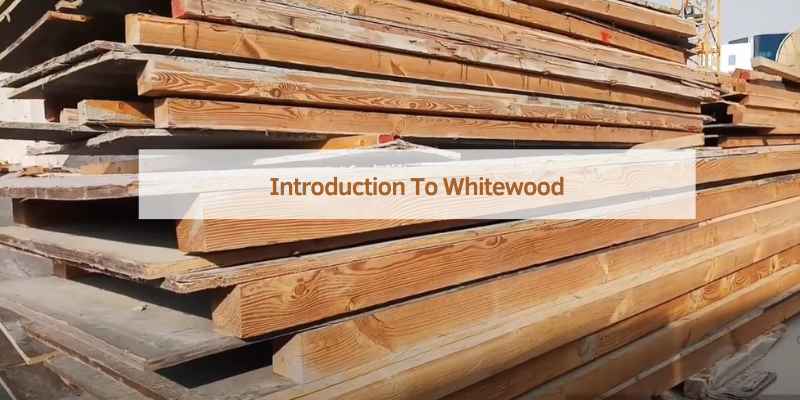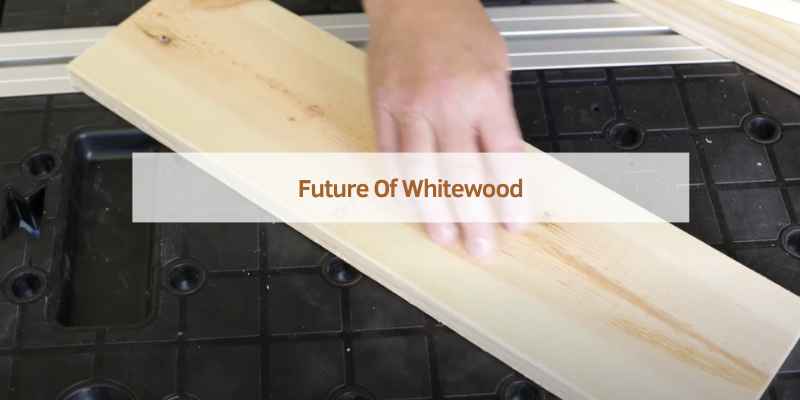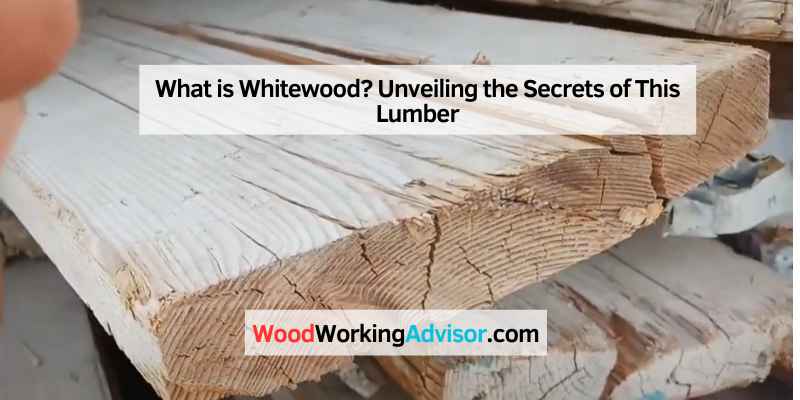Whitewood is a type of softwood commonly used in construction and furniture making. It is known for its light color and ease of staining.
Whitewood is often preferred for its affordability and versatility in various woodworking projects. This type of wood is sourced from different species, including pine, spruce, and fir, and is valued for its workability and smooth finish. Whether you are a DIY enthusiast or a professional carpenter, whitewood can be a great choice for creating durable and aesthetically pleasing pieces.
In this blog post, we will explore the characteristics, uses, and benefits of whitewood in more detail. Let’s delve into the world of this versatile and popular wood material.
Introduction To Whitewood
Whitewood, also known as white pine, is a type of softwood that is renowned for its light color and versatility. It is a popular choice for various woodworking projects and is valued for its aesthetic appeal and workability.
Origins And Sources
Whitewood is derived from various species of pine trees, including Eastern White Pine and Western White Pine. These trees are predominantly found in North America, particularly in regions such as the Great Lakes and the Eastern United States. The wood is sourced from sustainably managed forests, ensuring its availability for future generations.
Common Characteristics
- Light color with minimal grain pattern
- Soft and easy to work with hand or machine tools
- Resilient and durable for indoor applications
- Prone to dents and scratches due to its softness
- Excellent for painting, staining, or finishing

Types Of Whitewood Trees
Whitewood trees are a diverse group of trees known for their light-colored wood and various uses in construction, furniture making, and woodworking. These trees belong to different species and have distinct characteristics based on their geographical distribution and specific species varieties.
Species Varieties
Whitewood trees encompass a range of species, each with its own unique attributes. The most common types of whitewood trees include:
- Eastern White Pine (Pinus strobus)
- White Fir (Abies concolor)
- White Spruce (Picea glauca)
- White Cedar (Thuja occidentalis)
Geographical Distribution
Whitewood trees are distributed across various regions, each species thriving in specific climatic conditions. The geographical distribution of whitewood trees includes:
| Species | Geographical Distribution |
|---|---|
| Eastern White Pine | Eastern United States and Canada |
| White Fir | Western United States and Mexico |
| White Spruce | Northern United States and Canada |
| White Cedar | Eastern United States and Canada |
Physical And Mechanical Properties
Whitewood is a type of softwood commonly used in construction. It has a low density, making it easy to work with and ideal for projects requiring lightweight materials. Whitewood also has good mechanical properties such as strength and durability.
Whitewood is a term used to describe the wood from different species of trees that have a pale color. It is typically used for furniture, construction, and decorative purposes. The physical and mechanical properties of whitewood make it a popular choice for various applications. In this post, we will discuss the important physical and mechanical properties of whitewood, including grain and texture, strength, and durability.
Grain And Texture
Whitewood has a straight and even grain, which makes it easy to work with. The texture of whitewood is usually fine and uniform, which gives it a smooth and attractive appearance. The wood is also free from knots and other imperfections, which makes it ideal for painting or staining.
Strength And Durability
Whitewood is a softwood, which means it is not as strong as hardwood. However, it is still strong enough to be used for construction purposes. The wood has good shock resistance, which makes it suitable for furniture and other items that are subject to wear and tear. Whitewood is also resistant to decay and rot, which makes it a durable choice for outdoor projects.
Summary Table
For easy reference, we have summarized the physical and mechanical properties of whitewood in the following table:
| Property | Description |
|---|---|
| Grain and Texture | Straight and even grain with fine and uniform texture |
| Strength | Softwood, good shock resistance |
| Durability | Resistant to decay and rot |
In conclusion, whitewood is a popular choice for various applications due to its physical and mechanical properties. Its straight and even grain, fine texture, and good shock resistance make it easy to work with and suitable for furniture and construction projects. Additionally, its resistance to decay and rot make it a durable choice for outdoor projects.
Whitewood In Construction
Whitewood, commonly referred to as spruce or pine, is a type of softwood used in construction for its affordability and versatility. It is favored for framing, paneling, and general carpentry due to its strength and ease of working with.
Uses In Building
Comparison With Other Woods
Whitewood, commonly known for its versatility and durability, plays a crucial role in construction projects. Builders rely on whitewood for its strength and aesthetic appeal in various applications.
Uses in Building:
– Framing: Whitewood is popular for framing structures due to its strength.
– Flooring: Whitewood is a preferred choice for flooring due to its durability.
– Cabinetry: Whitewood is used in making cabinets for its fine texture and finish.
– Cladding: Whitewood is used for cladding due to its weather resistance.
Comparison with Other Woods:
| Whitewood | Other Woods |
|---|---|
| Strong and durable | Less durable |
| Affordable | Can be expensive |
| Easy to work with | May require special tools |
In construction, whitewood stands out for its versatility and cost-effectiveness compared to other types of wood.
Whitewood In Furniture Making
When it comes to furniture making, Whitewood is a popular choice due to its versatility and aesthetic appeal.
Design Flexibility
Whitewood offers design flexibility with its light color and smooth texture, making it ideal for various furniture styles.
Finishing And Treatment
Whitewood is easy to finish and treat, allowing for customized looks through staining or painting.
Sustainability And Environmental Impact
Whitewood is a sustainable building material with minimal environmental impact. It is sourced from fast-growing trees and promotes eco-friendly construction practices. Using Whitewood helps reduce carbon footprint and supports a greener future.
Whitewood, also known as spruce or pine, is a popular choice for furniture, construction, and other wood-based products. However, it is important to consider the sustainability and environmental impact of using whitewood in various industries. In this section, we will explore the forestry practices, certification, and regulations that ensure the responsible and sustainable use of whitewood.
Forestry Practices
Sustainable forestry practices are critical to ensuring the long-term availability of whitewood. These practices include clear-cutting, selective logging, and reforestation. Clear-cutting involves removing all trees in a designated area, while selective logging involves removing only certain trees. Reforestation involves planting new trees to replace the ones that were cut down. These practices help to maintain a healthy forest ecosystem and ensure that the forest can regenerate over time.
Certification And Regulation
Certification and regulation play a critical role in ensuring the responsible and sustainable use of whitewood. Organizations such as the Forest Stewardship Council (FSC) and the Programme for the Endorsement of Forest Certification (PEFC) provide certification to companies that adhere to strict environmental and social standards. This certification ensures that the wood used in products has been responsibly sourced and that the forests from which it was harvested are being managed in a sustainable way.
In addition to certification, there are also regulations in place to ensure the responsible use of whitewood. Governments around the world have implemented laws and regulations to protect forests and ensure that logging is done in a sustainable way. These regulations help to prevent illegal logging and protect sensitive forest ecosystems.
Overall, the sustainability and environmental impact of using whitewood depends on responsible forestry practices, certification, and regulation. By supporting companies that use responsibly sourced whitewood and advocating for sustainable forestry practices and regulations, we can help to ensure the long-term availability of this valuable resource.
Maintenance And Care For Whitewood Products
Whitewood is a popular choice for furniture and other wooden products due to its durability, versatility, and natural beauty. However, like any other material, whitewood requires proper maintenance and care to ensure its longevity and preserve its appearance. In this section, we will provide you with some essential tips on cleaning and maintaining your whitewood products, as well as practices to enhance their longevity.
Cleaning Tips
Keeping your whitewood products clean is essential to maintain their natural beauty and prevent any damage. Here are some cleaning tips to follow:
- Regularly dust your whitewood furniture with a soft, lint-free cloth to remove any surface particles.
- Avoid using abrasive cleaners or harsh chemicals that can damage the wood’s finish. Instead, opt for mild soapy water or a mixture of vinegar and water for gentle cleaning.
- When cleaning, always dampen the cloth or sponge instead of soaking it to prevent excess moisture from seeping into the wood.
- Gently wipe the surface in the direction of the wood grain to avoid scratching or damaging the finish.
- For stubborn stains, you can use a non-abrasive cleaner specifically designed for wood surfaces. Follow the instructions provided by the manufacturer.
- Once the cleaning is complete, make sure to dry the surface thoroughly with a clean, dry cloth.
Longevity Practices
Implementing proper longevity practices can significantly extend the lifespan of your whitewood products. Here are some practices to consider:
- Avoid placing whitewood furniture near direct sunlight or heat sources as prolonged exposure can cause fading or warping.
- Use coasters, placemats, or tablecloths to protect the surface from hot dishes, liquids, and scratches.
- Regularly inspect your whitewood products for any signs of damage, such as cracks or loose joints, and address them promptly to prevent further deterioration.
- Apply a protective finish or sealant to your whitewood furniture to enhance its resistance to moisture, stains, and scratches. Follow the manufacturer’s instructions for the specific product you choose.
- Consider using furniture polish or wax to nourish and protect the wood’s natural luster. Again, follow the product instructions for best results.
- Keep your whitewood products away from high humidity areas, as excessive moisture can cause swelling or warping of the wood.
By following these cleaning tips and longevity practices, you can ensure that your whitewood products remain in excellent condition for years to come. Remember, proper maintenance and care are crucial to preserve the beauty and functionality of your furniture and other wooden items.
Future Of Whitewood
Whitewood, also known as spruce or pine, has been a popular choice in the lumber industry for its versatility and affordability. As technology continues to advance and consumer demands evolve, the future of whitewood holds exciting opportunities for innovation and growth. In this article, we will explore the innovations in the lumber industry, market trends, and predictions that are shaping the future of whitewood.
Innovations In Lumber Industry
With advancements in technology, the lumber industry is embracing innovative practices to enhance the production and quality of whitewood. These innovations include:
- Automated Sorting and Grading: State-of-the-art machinery equipped with sensors and computer vision technology can quickly sort and grade whitewood based on its strength, appearance, and other characteristics, ensuring consistent quality.
- Precision Cutting and Milling: Computer-controlled saws and milling machines enable precise cutting and shaping of whitewood, reducing waste and maximizing the utilization of each log.
- Treatment and Preservation: New techniques for treating and preserving whitewood have been developed to enhance its durability and resistance to pests, weather, and decay, expanding its applications in construction and outdoor projects.
- Green Initiatives: Sustainability has become a key focus in the lumber industry. Forest management practices, such as responsible harvesting and reforestation, are being implemented to ensure a continuous supply of whitewood while preserving the environment.
Market Trends And Predictions
The market for whitewood is influenced by various trends and predictions that shape its future:
- Increasing Demand for Sustainable Materials: As consumers become more environmentally conscious, there is a growing demand for sustainable and eco-friendly materials like whitewood. This trend is expected to drive the market growth for whitewood in the coming years.
- Rise in Construction and Renovation Projects: The construction industry is experiencing a surge in residential and commercial projects, creating a significant demand for whitewood in applications such as framing, flooring, and furniture.
- Emerging Markets: Developing countries are witnessing rapid urbanization and infrastructure development, leading to an increased demand for whitewood in these regions. This presents new opportunities for exporters and suppliers of whitewood.
- Technological Integration: The integration of technology in the distribution and supply chain processes is expected to streamline operations, improve efficiency, and reduce costs, ultimately benefiting the whitewood industry.
The future of whitewood is promising, as innovations in the lumber industry and market trends align to create new possibilities. By embracing technology, sustainability, and meeting the evolving demands of consumers, whitewood is poised to remain a valuable and sought-after material in various industries.

Frequently Asked Questions
What Is Whitewood Used For?
Whitewood is commonly used in furniture making, construction, and woodworking projects. Its light color and smooth texture make it a popular choice for interior finishes and decorative moldings. It is also used for crafting musical instruments and as a material for carving and turning.
Is Whitewood Durable For Outdoor Use?
Whitewood is not recommended for outdoor use without proper treatment and protection. It is a softwood, making it more susceptible to rot and decay when exposed to outdoor elements. To use Whitewood outdoors, it’s essential to apply suitable finishes and regular maintenance to prolong its lifespan.
How To Maintain Whitewood Furniture?
To maintain Whitewood furniture, regularly dust with a soft cloth and avoid using harsh chemicals or abrasive materials that can damage the wood. Applying a protective finish, such as varnish or lacquer, can help preserve the wood and enhance its durability.
Additionally, keeping furniture away from direct sunlight and moisture is crucial for maintenance.
What Are The Advantages Of Whitewood?
Whitewood offers advantages such as ease of workability, making it ideal for crafting and woodworking projects. Its light color provides versatility for staining or painting according to desired aesthetics. Additionally, Whitewood is relatively affordable, making it accessible for various applications and DIY projects.
Conclusion
Whitewood is a versatile and popular type of wood that offers various benefits for furniture and construction projects. Its light color and smooth texture make it a desirable choice for many applications. Whether you’re looking to create a rustic or modern aesthetic, Whitewood can be easily customized and stained to suit your needs.
With its durability and affordability, it’s no wonder that Whitewood has become a go-to option for DIY enthusiasts and professionals alike. So, next time you embark on a woodworking project, consider using Whitewood for a high-quality and visually appealing result.


